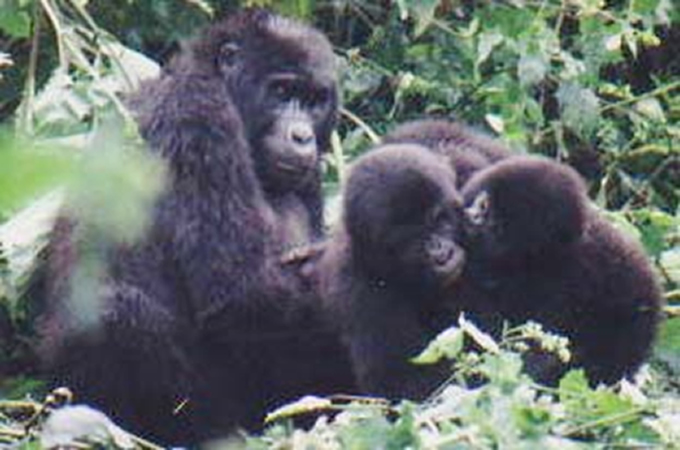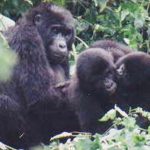For senior tourists, trekking through Bwindi’s challenging environment raises questions about feasibility, comfort, and accessibility. The park’s rugged topography, humid conditions, and unpredictable trail difficulty can be daunting, especially for those with mobility concerns or pre-existing health conditions. However, with appropriate planning, physical preparation, and logistical support, many older tourists complete the trek and describe it as rewarding.
This article comprehensively analyses the trek’s difficulty level for seniors, the challenges they may encounter, and practical strategies to improve the trekking experience. Additionally, it explores alternative options for those seeking a less physically demanding way to engage with Uganda’s mountain gorillas.
Difficulty of Bwindi Gorilla Treks
Bwindi Impenetrable National Park presents a physically demanding environment. Trekkers navigate an ecosystem shaped by irregular elevations, thick undergrowth, and unpredictable weather conditions. The difficulty of a gorilla trek varies based on factors such as the location of the assigned gorilla family, the chosen trekking sector, and individual fitness levels.
Topography and Elevation Challenges
Bwindi’s topography consists of rolling hills, steep slopes, and narrow footpaths winding through the forest. The park is located at an elevation ranging from approximately 1,160 to 2,607 meters (3,806 to 8,553 feet) above sea level, meaning trekkers experience moderate to high-altitude conditions. These elevation changes can affect oxygen levels, leading to increased exertion, especially for individuals not accustomed to hiking in elevated areas.
The trails used for trekking are often muddy and uneven, requiring careful footing to maintain stability. Some sections feature steep inclines that demand a sustained effort to ascend, while descents can be challenging due to loose soil and slippery surfaces, particularly during the rainy season.
Duration and Trekking Distance
The length of a gorilla trek depends on the location of the habituated gorilla group assigned on the day of the excursion. Some treks conclude within two to three hours, while others extend beyond five or six hours, covering several kilometres of rugged terrain. Rangers and guides determine the starting points based on where the gorillas were last seen, meaning there is no fixed trail or guaranteed trek duration.
Trekkers should be prepared for prolonged periods of walking, often at a slow but steady pace, with occasional stops for rest. The group’s capabilities dictate the overall pace, but individuals with limited endurance may find the prolonged exertion physically taxing.
Environmental Conditions
Bwindi’s forest has a humid micro climate, with temperatures ranging from 7°C to 27°C (45°F to 81°F). The combination of heat, humidity, and exertion can lead to dehydration if proper hydration is not maintained. Rain is frequent throughout the year, increasing the likelihood of muddy trails and reducing visibility in some sections. During the wet season (March to May and September to November), the trails become more challenging due to thick mud and waterlogged paths, which can slow movement and increase the risk of slipping.
Can Seniors Handle Bwindi Gorilla Treks?
Age alone does not determine whether a person can complete a gorilla trek in Bwindi. Fitness level, mobility, endurance, and overall health are more significant factors. Many seniors in their 60s, 70s, and even 80s have completed treks with proper preparation and support. The key considerations for seniors involve assessing physical capability, understanding potential risks, and making informed choices about the trek’s difficulty level.
Fitness and Physical Condition Over Age
Gorilla trekking requires moderate to high physical exertion, depending on the distance and difficulty of the route assigned. Seniors with an active lifestyle, including regular walking, hiking, or strength training, are better prepared to handle the physical demands. Joint health, cardiovascular endurance, and overall mobility are more significant than numerical age in determining a trekker’s ability to complete the hike.
Medical clearance is recommended for seniors with pre-existing conditions such as arthritis, heart issues, or respiratory limitations. Those with knee or back problems should consider whether they can handle long hours of walking on uneven ground.
Real-Life Examples of Senior Trekkers in Bwindi
Many older trekkers have completed Bwindi gorilla treks, demonstrating that the experience is not limited to younger individuals. Some have done so with the assistance of porters, trekking poles, and pre-arranged shorter routes.
For example, several accounts highlight individuals in their late 70s and early 80s who have managed the trek by choosing easier trails and utilising extra support. Porters assist by carrying bags and offering physical support on challenging trek sections. This significantly reduces fatigue and improves stability on slippery slopes.
Expert Insights on Senior-Friendly Trekking
Guides and conservation experts emphasize that the trek can be adjusted to accommodate seniors. Some gorilla families are closer to the starting point, reducing the need for extended hikes. By informing park officials about physical limitations in advance, seniors can request a less strenuous trek.
While Bwindi’s trekking conditions remain physically demanding, those who prepare adequately and take advantage of available assistance options can complete the journey. It remains essential to assess one’s capabilities realistically and plan accordingly to enhance comfort and safety.
Challenges Seniors May Face
Gorilla trekking in Bwindi requires physical exertion, mental resilience, and adaptability to unpredictable natural conditions. Understanding these challenges helps make informed preparations to mitigate risks and enhance the trekking experience.
Altitude and Breathing Difficulties
Bwindi’s elevation ranges between 1,160 and 2,607 meters (3,806 to 8,553 feet) above sea level, creating an environment where oxygen levels are slightly lower than at lower altitudes. While this is not considered extreme altitude, some seniors may experience shortness of breath or mild altitude discomfort, mainly if they are not accustomed to hiking at higher elevations. Those with respiratory conditions such as asthma or chronic obstructive pulmonary disease (COPD) should consult a doctor before attempting the trek.
Taking breaks, maintaining a steady pace, and staying hydrated can help mitigate altitude-related discomfort. Seniors who experience symptoms such as dizziness, excessive fatigue, or nausea should inform their guide immediately.
Slippery Trails and Uneven Paths
The footpaths in Bwindi are narrow and often covered in exposed roots, loose soil, and occasional rock formations. Rainfall—frequent in the park—makes these trails even more challenging, increasing the risk of slips and falls. Steep ascents and descents can be particularly difficult for individuals with knee or joint issues.
Proper hiking boots with good ankle support and a firm grip are essential for stability. Trekking poles help reduce knee strain while providing additional balance on uneven sections. Seniors concerned about mobility can also hire a porter for extra assistance when navigating difficult portions of the trail.
Weather Conditions: Rain, Mud, and Temperature Fluctuations
Bwindi has a tropical rainforest climate, meaning that rainfall is possible at any time of the year. The wettest months—March to May and September to November—bring heavier rain, making the trails more challenging. Even during drier months, occasional showers can create slippery conditions.
Humidity is another factor, especially in the lower-altitude sections of the park, where temperatures can feel warmer despite being in a forested environment. Seniors sensitive to humidity or heat should take hydration seriously and wear moisture-wicking clothing to stay comfortable.
Fatigue and Stamina Limitations
The trek can last anywhere from two to six hours or more, depending on the location of the gorilla group. Seniors not used to prolonged physical activity may experience fatigue, particularly on continuous climbing routes. Breaks are incorporated into the trek, but personal endurance levels will influence how manageable the experience feels.
To reduce fatigue, it is advisable to start physical preparation weeks or months in advance, focusing on endurance-building exercises such as walking, stair climbing, or light hiking. Hiring a porter to assist with carrying a backpack and providing occasional support during steep sections can also significantly improve energy conservation.
How Seniors Can Prepare for a Successful Trek
Fitness and Endurance Training
Seniors planning to trek in Bwindi should focus on building endurance, strength, and balance several weeks or months in advance. The trek requires prolonged walking, sometimes on steep or muddy trails, so improving cardiovascular health and muscular endurance is important.
Recommended exercises include:
- Walking or hiking: Aim for at least 30–60 minutes of brisk walking or moderate hiking several times a week. This helps condition the legs and improve stamina.
- Strength training: Focus on lower-body strength with exercises such as squats, lunges, and step-ups to improve stability on uneven terrain.
- Flexibility and mobility work: Stretching exercises and yoga help enhance joint flexibility and reduce stiffness.
- Stair climbing: Since some trails have steep sections, practicing stair climbing strengthens leg muscles and improves endurance for uphill trekking.
Seniors with pre-existing conditions should seek medical advice before beginning a training regimen or committing to the trek.
Choosing the Right Trek and Gorilla Group
The difficulty of a gorilla trek depends mainly on the location of the assigned gorilla group. Some groups are closer to the trailhead, requiring less walking, while others require several hours of trekking.
Seniors should request an easier trek when booking their permits. The Buhoma sector of Bwindi is known for having relatively shorter and more accessible treks than sectors like Ruhija or Nkuringo, which are steeper and more demanding. While there is no guarantee of being assigned a specific group, park authorities try to accommodate requests for shorter treks when informed in advance.
Hiring Porters for Assistance
Porters are available at the start of every trek and provide critical support, particularly for seniors. A porter can:
- Carry backpacks, reducing physical strain.
- Assist with steep or slippery sections.
- Offer an extra hand for stability, helping to prevent falls.
Hiring a porter is highly recommended for seniors, as it makes the trek significantly more manageable and allows trekkers to focus on the experience rather than exert unnecessary energy.
Pacing and Hydration Strategies
Treks in Bwindi are conducted moderately, with rest stops as needed. Seniors should walk at a comfortable speed, avoiding excessive strain. Guides accommodate different fitness levels and ensure that trekkers do not overexert themselves.
Maintaining hydration is essential, as sweating and exertion can lead to dehydration. It is advisable to drink small amounts frequently rather than waiting until feeling thirsty.


